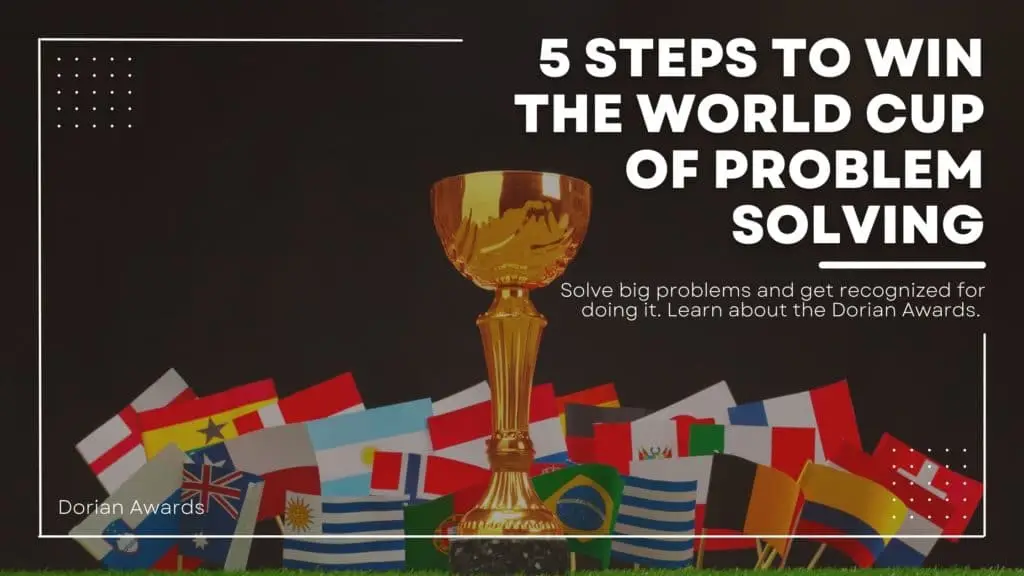
The screech of a ref’s whistle, the rumble of thousands of fans, and the droning blasts of vuvuzelas before an elated, elongated, “GOOOOOOOOAL!”
If you’re a fútbol fan, you know this excitement is never as palpable as at the World Cup. Teams train for years for the chance to compete at this highest level. Coaches develop intricate strategies to boost their team’s chances. Associations pour time and effort into vying for this ultimate bragging right. There’s nothing like it. Right?
A clandestine meeting between engineers in a darkened parking lot hastens the exchange and dissection of malfunctioning parts. A family legacy unites a team to achieve a goal a quarter of a century old. An overturned strategy and a come-from-behind solution bring a six-year-long problem to a permanent and climactic close.
The Dorian Awards may not be quite as thrilling for spectators to watch, but it’s not a stretch to imagine the Dorian Awards as the World Cup of Red X® Problem Solving. The strategizing, exertion, and inimitable skill that goes into winning the Dorian Awards and the global respect and reputation that follow finalists and winners can’t be understated.

Whether you’d like to shine a spotlight on your department, celebrate a team’s hard work, or boost your company or plant’s reputation, there are five steps you’ll need to study and execute to improve your chances of winning a Dorian Award in the coming year.
1) Know the rules
This may seem like a given, but it’s essential to know the rules of the game. Just like in the World Cup where Referees make sure that all teams are adhering to the rules, the Dorian Awards have rules too. Before jumping in, consult the criteria for the award you would like a leader (like yourself!), a project, or your company to be nominated for. Don’t wait! Look at it now so you can start brainstorming ideas for which projects and teams might be the best to compete in the Problem Solving World Cup. Once you’ve got a few ideas, you’ll want to be sure to:
- Double check that the category requirements are met
- Become familiar with the deadlines for project, personnel and company submissions
- Mark those dates on your calendar AND set a reminder 30 days prior to help you prepare to make your submissions
- Make sure that the projects you submit are completed within the relevant year
Wondering where and when you can get all that information? You can start by reviewing the latest Dorian Award Winners and Criteria. Throughout the year, we’ll send information and reminders about the “World Cup of Problem Solving” so that you have the best possible chance of bringing home a big win for your team, a Dorian Award.
If you need a refresher on choosing impactful projects, head to the Collaboration Platform and check out your RT5 folder or check out our article on Selecting Focused Projects.
2) Choose the right project
When choosing the right projects for your teams to tackle, there are some problems that will immediately stand out. A high scrap rate or a reliability problem with a part are good places to start. But after you solve visible problems, there are still high-impact problems that can help your team demonstrate the technical prowess and impressive savings that win awards. These problems can be identified by grouping like events and employing some of the tools you’ve already acquired in your toolbox.
If you need a refresher on choosing impactful projects, head to the Collaboration Platform and check out your RT5 folder or check out our article on Selecting Focused Projects.
3) Enhance the Communication
Nothing can stall a project like lack of communication. And as a leader in your company, it’s essential you’re able to speak to the benefits of your teams’ projects. When the value of projects is not adequately presented, the project may be at risk of collapse. Whether funding becomes insufficient, a new strategy is proposed, or key team members are relocated to another team, there are constant threats to project completion. By accurately conveying the strategy and value of your teams’ projects, you will minimize the risk of the project failing.
4) Remove the Roadblocks
We’re never free from politics–not even within an organization. There’s always a tangle of red tape, processes, and people to consult before anything can move forward. But that’s where you come in.
While completing the projects that will help your company grow, your department deliver results, and you rise in the ranks, your team is going to stumble on obstacles. It is your job to remove those roadblocks with polite bureaucratic expertise and internal politicking. Whatever it takes, you need to pave the way for your team’s success so they can focus on execution. For more information, visit the RT5 folder on the Collaboration Platform.
5) Execute Confidently
Unfortunately, the work isn’t over once your team has located the root cause. The last step in the process is to ensure your team has fully executed the solution that will mitigate the root cause. Focus is key here. Make sure your team stays on track until they are past the finish line, and continue to protect them from internal politics until that time.
Then, nominate the project, a leader, or your company for a Dorian Award by submitting all relevant documentation. Be confident that you have done everything you can to achieve a boosted bottom line, improved customer relationships, and increased employee morale. The acclaim and reputation from the awards will follow.
If you’ve followed these five steps, you’re ready to play in the World Cup of Red X® Problem Solving! We look forward to seeing what you’ve accomplished this year. Submit your projects for nomination here.




